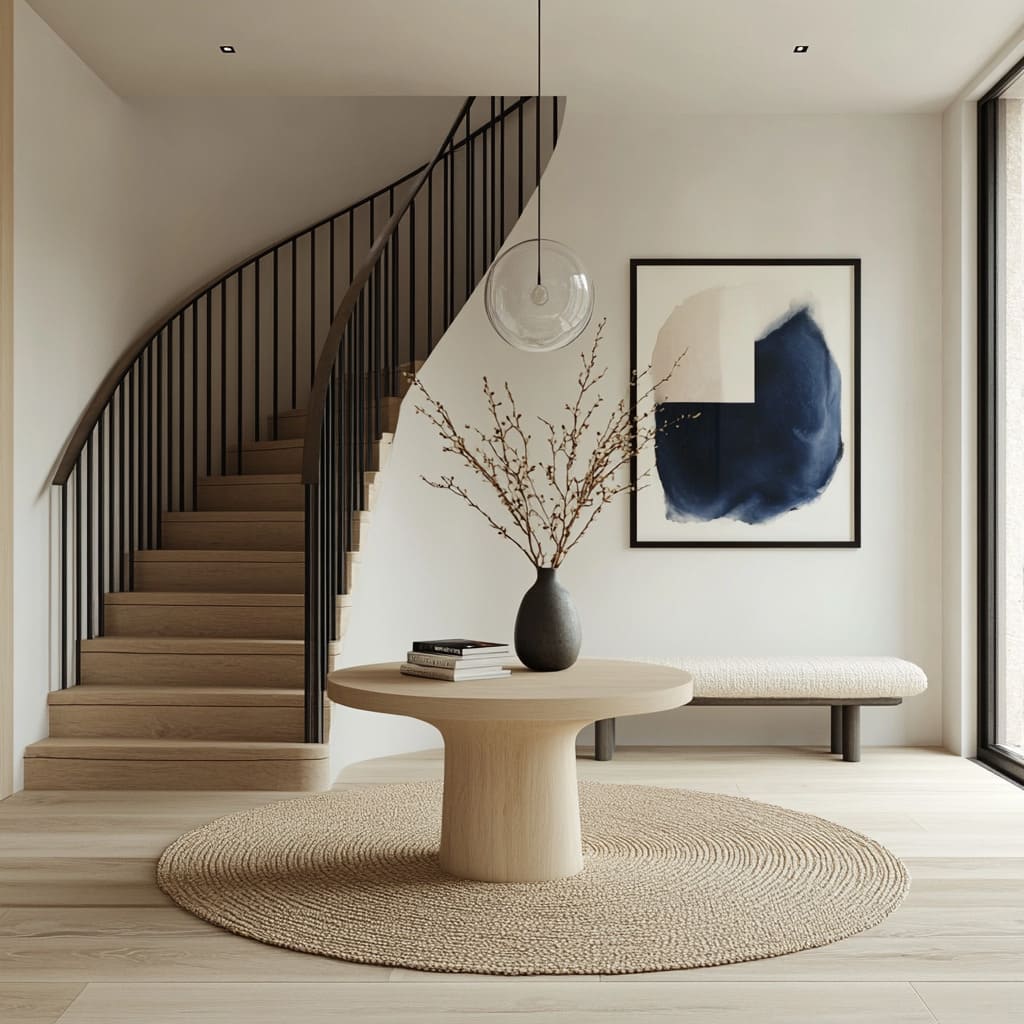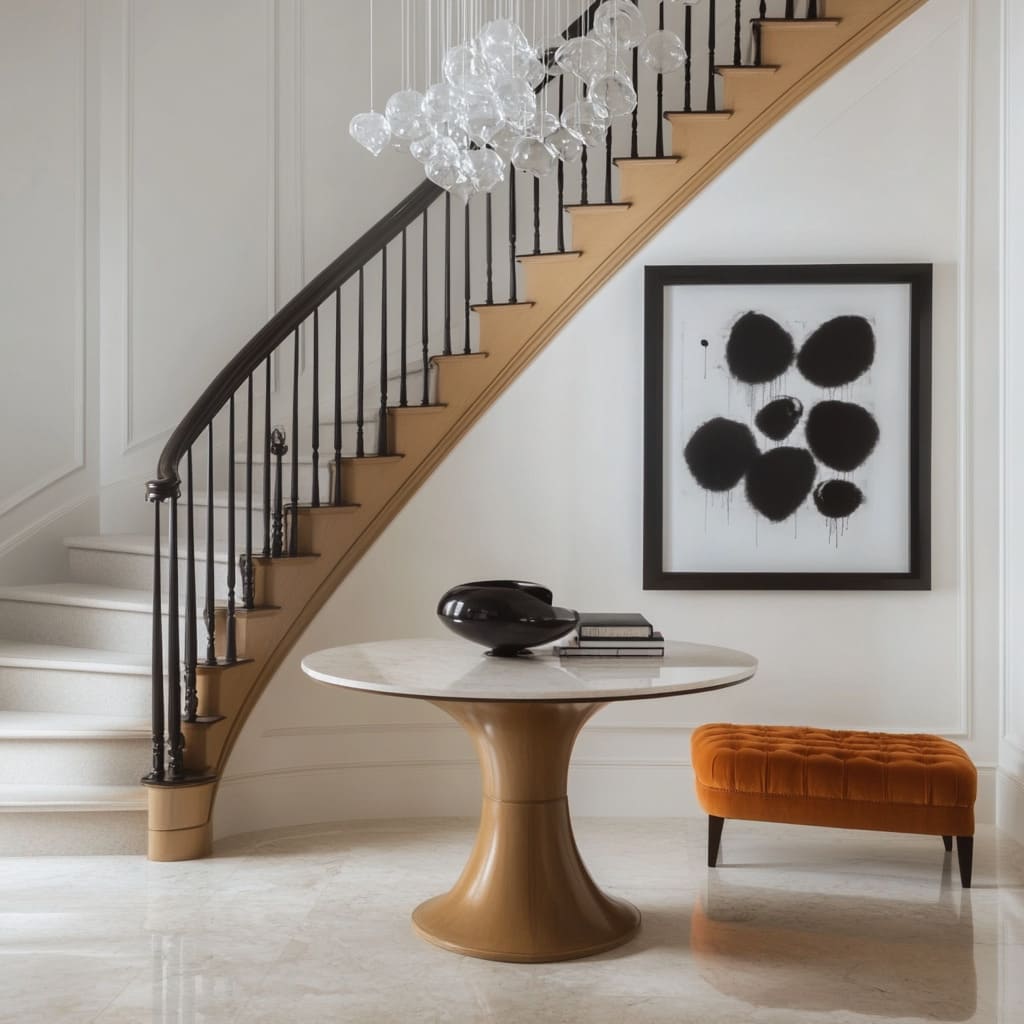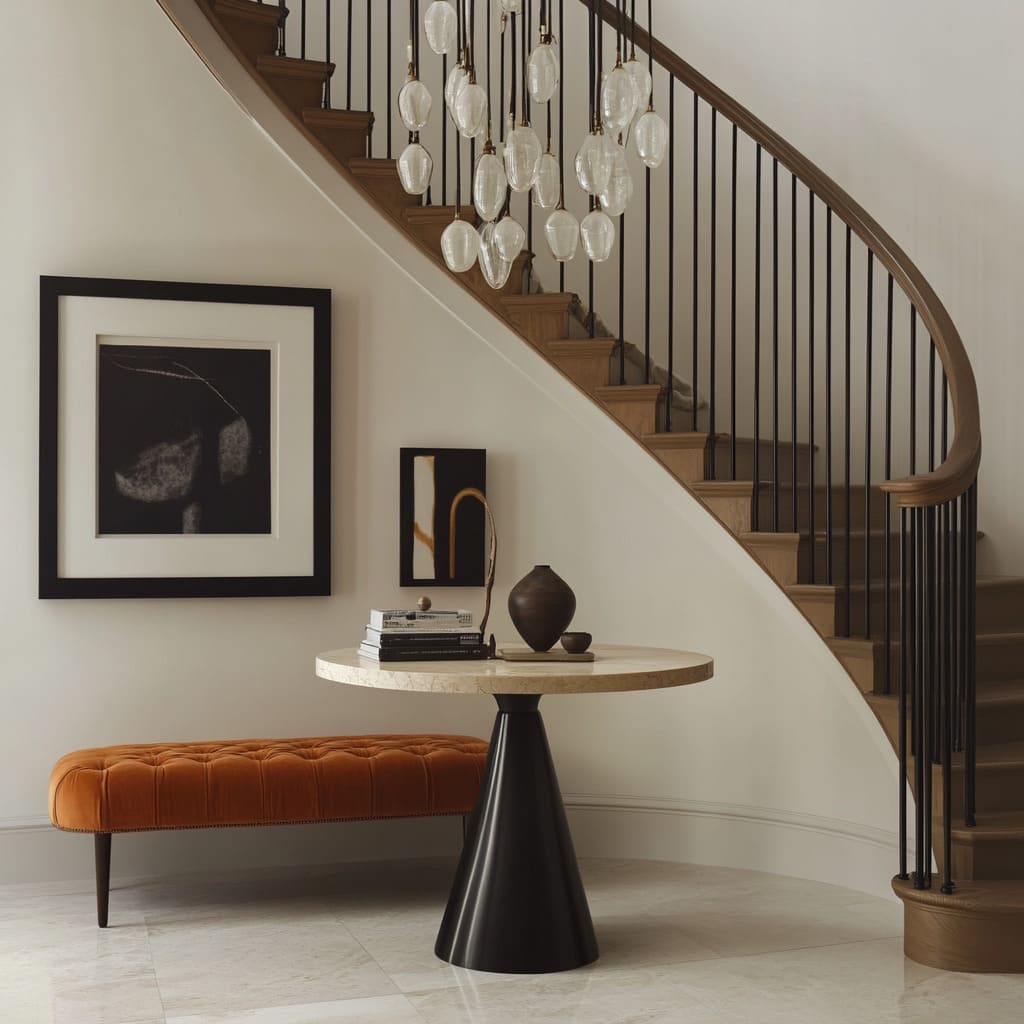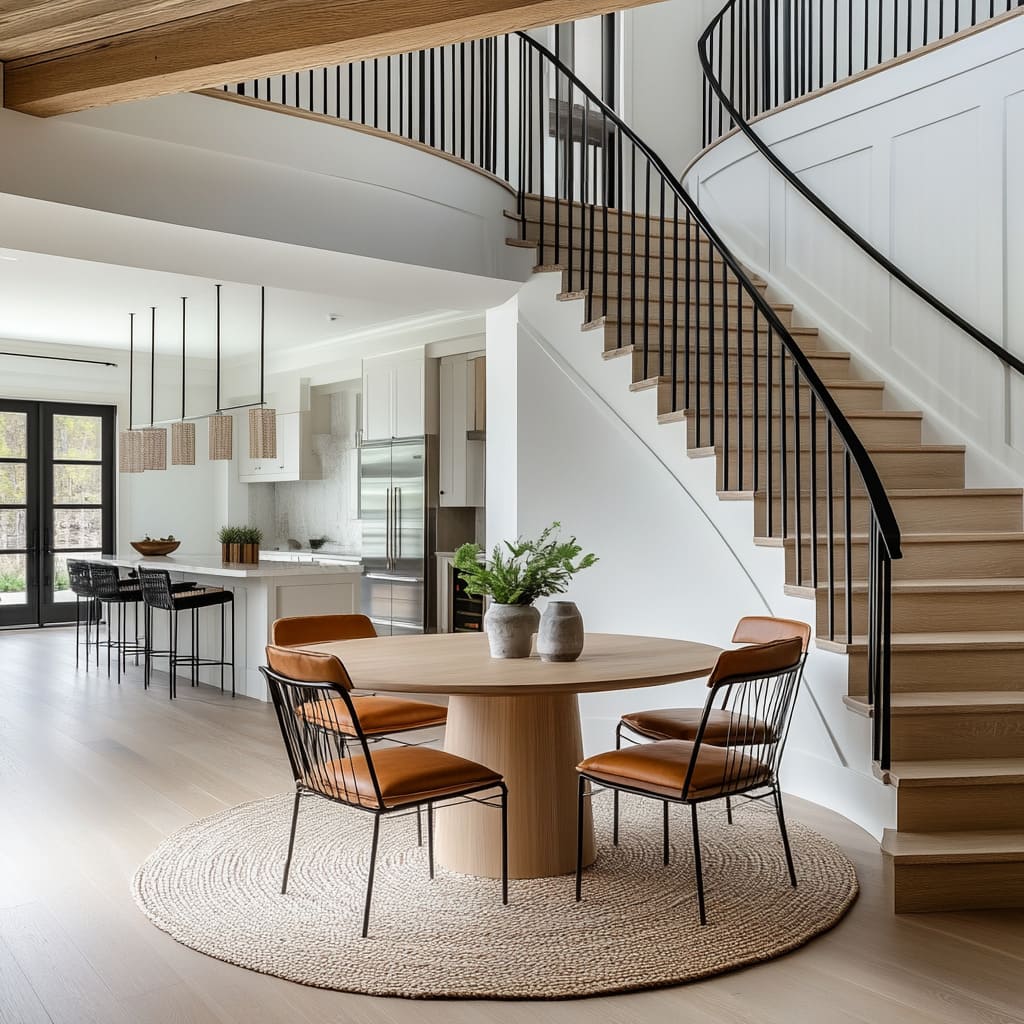Modern minimalist curved staircases have emerged as a defining element in interior design, transforming ordinary spaces into visually striking environments. These architectural features go beyond function, merging practicality with artistry to enhance the overall aesthetic of a home.
The smooth, sweeping lines of rounded stairs instantly capture attention, making them more than just a means of connecting floors—they become a sculptural centerpiece. Whether incorporated into cozy nooks or expansive foyers, these staircases adapt effortlessly to various layouts, offering versatility that complements both traditional and contemporary styles.
They create a sense of flow that ties together open spaces while also maximizing functionality in compact areas. With their ability to blend seamlessly into any design vision, modern curved staircase ideas continue to inspire homeowners and designers alike.
Why Curved Staircases are the Ultimate Statement Piece
The beauty of a curved staircase lies in its ability to transform an ordinary room into something extraordinary. Unlike straight designs, the continuous arc of a curved staircase invites the eye to move naturally along its contours, adding depth and dimension to a space.
Its flowing lines create an organic rhythm that softens the rigid geometry often found in modern interiors. Beyond aesthetics, a curved staircase can make a room feel more cohesive.
By guiding movement and defining spaces, it acts as both a functional structure and an artistic focal point. For instance, in open-concept homes, curved staircases seamlessly divide living and dining areas without the need for walls, maintaining the openness while introducing subtle boundaries.
The charm extends to smaller homes too. In compact spaces, a curved staircase banister with slender, minimalist railings can create an illusion of openness, allowing light to move freely and preventing the area from feeling cramped.
These designs add a touch of elegance while maximizing usability, proving that even smaller layouts can benefit from their graceful presence. Whether set against the backdrop of large windows or tucked into a quiet corner, curved staircases redefine how we perceive movement within a home.
They do more than connect floors—they elevate the experience of living in the space, turning functional stairways into works of art.
Materials that Define Minimalist Curved Staircases
The choice of materials plays a pivotal role in defining the character of minimalist curved staircase designs. Each material brings its own personality, whether it’s warm and inviting, sleek and modern, or luxurious and refined.
Wood
Natural wood tones remain a favorite for creating warmth and softness in curved staircases. From light oak to rich walnut, wood provides a timeless quality that blends effortlessly into both contemporary and transitional spaces.
Its texture and grain add depth, making the staircase a harmonious addition to any home. Designers often pair wooden treads with contrasting elements, such as metal or glass, to highlight the staircase’s sculptural quality while maintaining its welcoming appeal.
Metal
For those seeking a bold and modern look, metal accents are a go-to choice. Sleek black or brass balusters stand out as both functional and decorative elements, offering clean lines that enhance the simplicity of the overall design.
Metal is particularly effective in open-concept spaces, where it creates a striking contrast against light walls or natural wood finishes. Its durability also makes it a practical option, combining style with long-lasting performance.
Glass
Glass brings a sense of openness and light to curved staircases. Whether it’s used as a railing or in combination with cable designs, glass amplifies the airy quality of the space.
This is an ideal choice for homes that emphasize transparency and flow, as glass railings allow the staircase to blend seamlessly with its surroundings. The reflective surface also plays beautifully with natural light, creating an interplay of brightness that adds dimension to the staircase.
Stone and Marble
For a more luxurious feel, polished stone and marble treads elevate the look of any modern curved staircase. These materials introduce a sleek finish that complements minimalist aesthetics while adding a touch of sophistication.
Neutral-colored marble, paired with metal or glass accents, creates a refined visual balance that works well in homes aiming for understated opulence.
Staircase Railings: A Balancing Act Between Functionality and Style
The railing design of a staircase is as important as the staircase itself, defining its overall look while ensuring safety. Curved stair railings, whether crafted from wood, metal, or glass, contribute significantly to the staircase’s personality, making them an integral part of the design.
Wooden Railings
Wooden railings exude warmth and timeless charm, complementing the natural curves of the staircase. Paired with matching wooden treads, these railings emphasize unity and simplicity, which are hallmarks of minimalist interiors.
They work particularly well in homes where organic textures are a key design element.
Metal Railings
Metal railings, especially those in black or brass, are often chosen for their modern edge. Thin metal balusters create a striking linear effect, offering contrast to the soft curves of the staircase.
This style is especially popular in homes that lean toward industrial or modern themes, where clean lines and bold finishes define the aesthetic.
Cable or Glass Railings
For those who value openness, cable or glass railings are a standout choice. These designs create an uninterrupted visual flow, making the staircase appear almost weightless.
Glass, in particular, is often paired with modern curved staircases to enhance their sculptural appeal without overshadowing the surrounding decor.
Impact on the Space
Railings do more than provide support—they set the tone for the entire staircase. Bold contrasts, like black railings on light wood, create a dramatic centerpiece, while seamless glass railings allow the staircase to integrate subtly into the room.
The growing trend of minimalist railings reflects a preference for designs that prioritize openness, ensuring safety without overwhelming the aesthetic balance of the space. Ultimately, railings aren’t just a functional component; they’re a design choice that completes the story of a staircase, turning it into a cohesive feature that elevates the overall interior.
Whether you’re exploring curved staircase ideas or reimagining an existing space, the railing design can make all the difference.
Lighting: Enhancing the Beauty of Curved Staircases
Lighting is one of the most critical elements in showcasing the full potential of curved staircases, transforming them from structural necessities into artistic focal points. Thoughtfully placed lighting not only illuminates but also highlights the staircase’s design, materials, and surrounding decor.
Pendant Lighting
Cascading pendant lights are a perfect match for modern curved staircases. Suspended at varying heights, frosted or amber globes introduce a sense of rhythm and flow that mirrors the gentle curve of the staircase itself.
These lights draw the eye upward, emphasizing the staircase’s height and graceful movement. In homes with high ceilings, a collection of pendants hung in an asymmetric cluster creates visual drama while maintaining the staircase’s modern aesthetic.
The frosted finish softens the glow, adding warmth to the surrounding space.
Chandeliers
In larger spaces, bold chandeliers can transform a staircase into a statement piece. Designs like sputnik chandeliers or those with teardrop-shaped glass elements work beautifully to create a striking contrast with the clean lines of the staircase.
Positioned directly above an arched staircase, a dramatic chandelier not only defines the space but also complements its architectural elegance. The interplay of materials, such as polished metal or textured glass, against natural wood or stone further enhances the overall design.
Natural Light
Nothing complements a curved stair banister quite like natural light. Floor-to-ceiling windows positioned near the staircase allow sunlight to accentuate its materials and contours.
Whether the treads are made of light wood, stone, or marble, the natural light amplifies their textures and tones. In spaces where large windows frame the staircase, the combination of organic light and architectural design creates a timeless, airy atmosphere.
The reflection of daylight on glass railings or polished finishes adds an extra layer of sophistication.
Curved Staircases in Small Spaces: Maximizing Elegance
Curved staircases aren’t exclusive to sprawling homes—they can bring just as much charm and functionality to smaller layouts. With careful design, these staircases make the most of limited space while maintaining a sense of openness and sophistication.
Compact Layouts and Design Opportunities
The flowing lines of a curved staircase naturally suit compact spaces, as they occupy less visual bulk compared to straight designs. In cozy interiors, the curve softens corners and creates a sense of movement without overwhelming the room.
An arched staircase tucked into a corner of a living or dining area is an excellent example of how this design can make the space feel larger. The absence of harsh angles allows the staircase to blend seamlessly with its surroundings, rather than imposing on the room.
Optimizing Space with Functional Additions
Curved designs often leave an open area beneath the stairs, which can be creatively utilized to enhance functionality. Built-in benches or custom seating along the curve provide a practical solution that doubles as a decorative element.
Upholstered cushions in neutral tones maintain a minimalist look while adding comfort. Alternatively, this area can house a round table or a compact console, creating a nook that feels intentional rather than wasted.
Minimal Decor for Maximum Impact
Decorating around a curved staircase requires a delicate touch to avoid cluttering the space. Abstract art, positioned strategically on nearby walls, adds depth and personality without competing with the staircase’s design.
A small table with a textured vase or a sleek lamp beneath the stairs adds charm while staying true to minimalist principles. The key is to let the staircase remain the focal point, while the surrounding decor quietly complements its presence.
By thoughtfully integrating these elements, even the smallest spaces can benefit from the beauty and functionality of curved staircases, proving that size isn’t a limitation when it comes to stunning design.
Curved Staircases as Part of an Open Concept Design
Curved staircases bring an undeniable charm to open concept layouts, serving as seamless yet defining elements that balance function and style. Their soft, flowing lines naturally divide spaces like living rooms, dining areas, and kitchens without creating physical barriers, maintaining the airy feel that open floor plans are known for.
A contemporary curved staircase, in particular, stands out for its ability to create visual interest while anchoring the design of adjoining areas. The beauty of curved staircases lies in their adaptability.
In a home with a dining area adjacent to the staircase, pairing textures such as jute rugs, soft leather chairs, and warm wood finishes enhances the cohesive nature of the design. The rug adds grounding to the open space, while leather and upholstery create warmth and comfort.
Whether positioned near large windows or blending with neutral palettes, curved staircases complement the surrounding decor while acting as subtle focal points. These staircases also integrate beautifully with diverse styles.
In kitchens or living spaces that embrace a minimalist aesthetic, the staircase’s smooth form offers an understated contrast to sharp cabinetry lines or angular furniture. For homes featuring more traditional accents, its presence bridges the gap between timeless and modern, making it a versatile centerpiece that harmonizes different zones of the home.
Art and Accessories: Styling Around Curved Staircases
Curved staircases provide an incredible opportunity to enhance your interior styling with carefully chosen art and accessories. Whether your staircase sweeps through a spacious entryway or nestles into a cozy corner, its surrounding decor can highlight its design while creating a welcoming atmosphere.
Abstract Art
Abstract art is a perfect match for curved staircases, as its fluid forms and bold strokes echo the staircase’s natural movement. Large, neutral-toned pieces can add a calming balance to the structure, while vibrant works introduce energy to the space.
Placing oversized artwork on the adjacent wall draws attention to the staircase, while smaller, gallery-style arrangements add subtle depth. The interplay between the art and the staircase creates an engaging design that feels intentional yet effortless.
Furniture Pairings
The area beneath a curved staircase is prime real estate for stylish yet functional furniture. Statement benches upholstered in textured fabric or soft leather add comfort and charm without overwhelming the space.
Round tables fit naturally within the curve, echoing its shape while offering a spot for decorative accents like books, vases, or sculptures. Plush ottomans can also be placed beneath the stairs, introducing another layer of softness and utility.
These thoughtful additions enhance the space’s usability while emphasizing the staircase’s sculptural beauty.
Natural Accents
Adding greenery or dried branches near the staircase can soften its modern edges while introducing organic textures. A tall, minimalist vase filled with branches can draw the eye upward, emphasizing the curve and height of the staircase.
Smaller plants or earthy tones in planters bring life to the space, creating a subtle contrast with the polished finishes of the staircase. These accents complement curved stair ideas, adding warmth and personality to the overall design.
Styling around curved staircases is an exercise in balance—each accessory or furniture choice should enhance the staircase’s presence without overpowering its natural grace. By blending abstract art, functional furnishings, and natural elements, the staircase becomes not just a functional element, but a dynamic and harmonious part of the home’s story.
Functional and Stylish Additions to Staircase Areas
Curved staircases create a unique opportunity to enhance the surrounding space with elements that are both practical and visually appealing. The area beneath these structures, often overlooked, can be transformed into a cohesive and inviting part of the home.
Built-in Seating
For those looking to add both form and function, custom benches or banquettes designed to fit the curve of the staircase offer a seamless solution. Built-in seating is especially effective in round stairs design, where the arc of the bench follows the natural flow of the staircase.
Upholstered with soft fabrics or neutral tones, these additions provide a cozy spot to relax or add character to an entryway. Adding plush throw pillows or subtle decorative elements can further integrate the seating with the surrounding decor.
Multi-Functional Decor
Filling the space beneath the staircase with thoughtfully chosen decor is another way to elevate the area’s appeal. A small side table paired with a vase of dried branches or a stack of coffee table books can add a curated touch.
These items are not just fillers—they contribute to the room’s overall narrative, blending seamlessly with the staircase’s materials and colors. Whether minimal or bold, the right combination of decor elements can turn an unused nook into an eye-catching feature.
Area Rugs
Round or textured rugs are excellent for visually anchoring a staircase within the larger space. Positioned at the base of a wood circular staircase, a well-chosen rug adds warmth and depth, highlighting the staircase as a design feature.
Textured or patterned rugs also create subtle contrasts that bring balance to modern minimalist interiors. Opt for natural fibers or muted tones to maintain the staircase’s understated elegance, or go for bold patterns to add a dash of personality.
Creating a Focal Point with Staircase Colors and Finishes
The colors and finishes of a staircase play a pivotal role in defining its presence within a home. Whether subtle or bold, these choices contribute to making the staircase a standout feature.
Contrast and Cohesion
One of the most striking ways to emphasize a staircase is through the use of contrasting materials. Dark balusters paired with light walls or wood tones create a dynamic look, drawing attention to the staircase’s architectural details.
This contrast is particularly effective in open layouts, where the staircase acts as a visual anchor without dominating the space. The combination of black metal railings and pale wood treads, for example, strikes a balance between modern sophistication and timeless appeal.
Neutral Palettes
Neutral tones like beige, cream, and white are staples in modern staircases, offering a clean and versatile aesthetic. These colors allow the natural beauty of materials, such as wood or glass, to shine.
Neutral palettes also provide flexibility, making it easy to pair the staircase with a variety of interior styles, from Scandinavian simplicity to mid-century modern warmth.
Pops of Color
While neutrals dominate, vibrant hues can add a lively touch to the surrounding area. Furniture or decor near the staircase, such as an orange bench or navy cushions, can introduce a fresh element without overwhelming the overall design.
These pops of color work particularly well in minimalist spaces, where each detail is intentional and impactful. By combining understated finishes with bold accents, the staircase area becomes a harmonious blend of subtlety and personality.
When thoughtfully integrated, colors and finishes not only enhance the staircase itself but also tie it into the broader design of the home, making it an unforgettable centerpiece.
Conclusion
Modern minimalist curved staircases have proven to be far more than functional structures; they are transformative design features that define the character of a home. Their flowing lines and versatile adaptability create an undeniable visual impact, seamlessly bridging practicality and artistry.
Whether positioned as the centerpiece of an open-plan layout or tucked into a compact space, a beautiful curved staircase commands attention and elevates the entire interior. By blending innovative materials, striking finishes, and thoughtful decor, these staircases not only enhance the functionality of a home but also contribute to its personality and charm.
As both focal points and unifying elements, they embody the perfect balance between subtle elegance and bold design, solidifying their place as timeless features in contemporary interiors.























